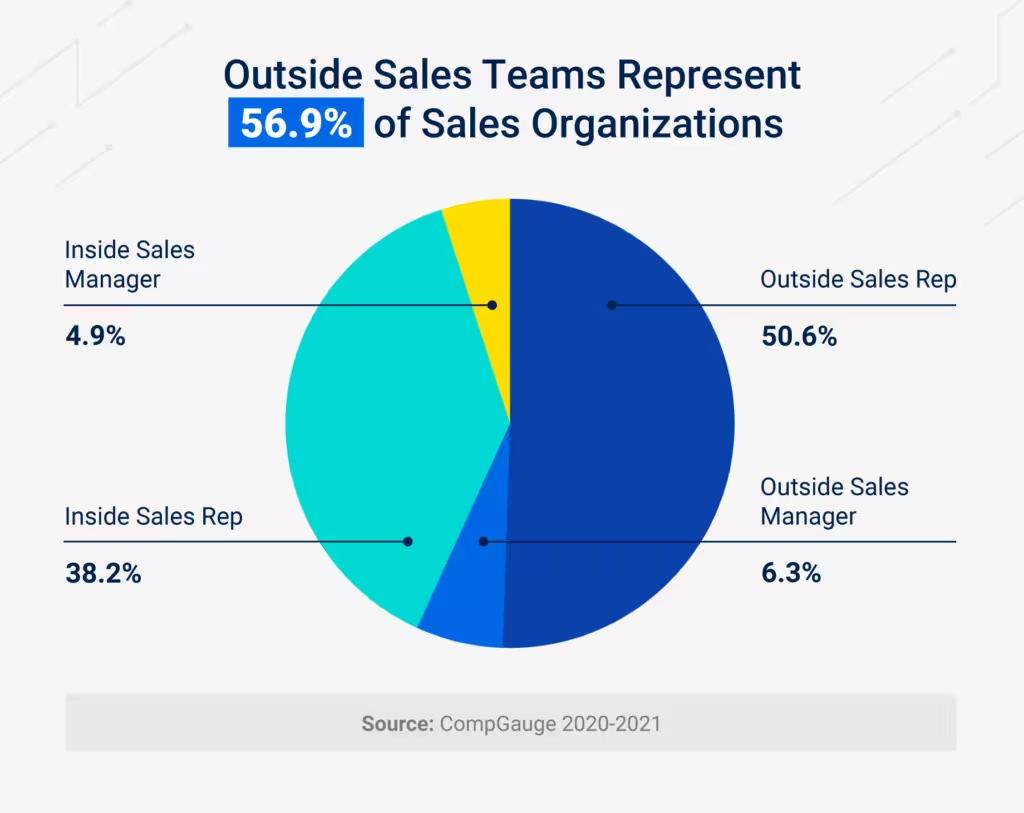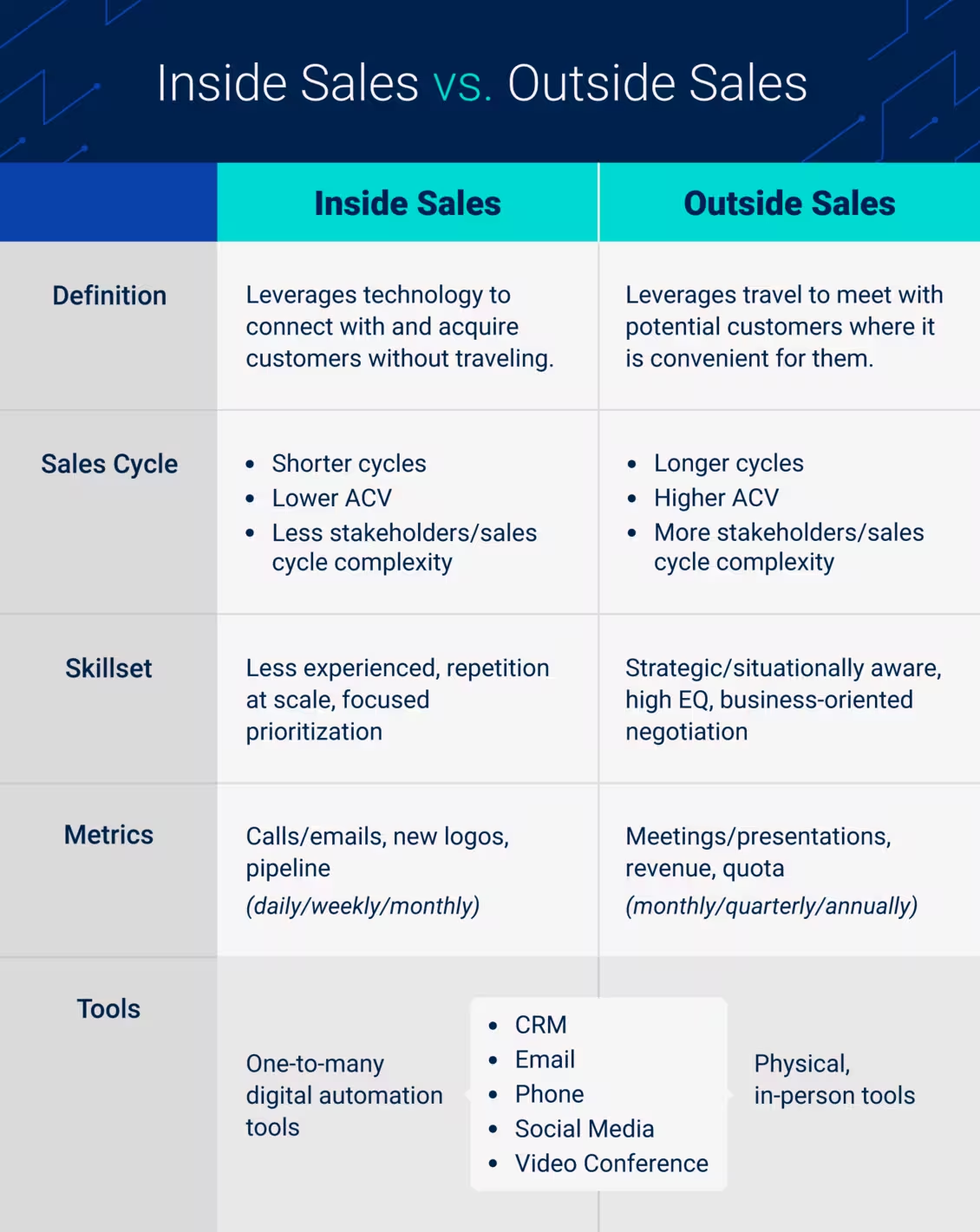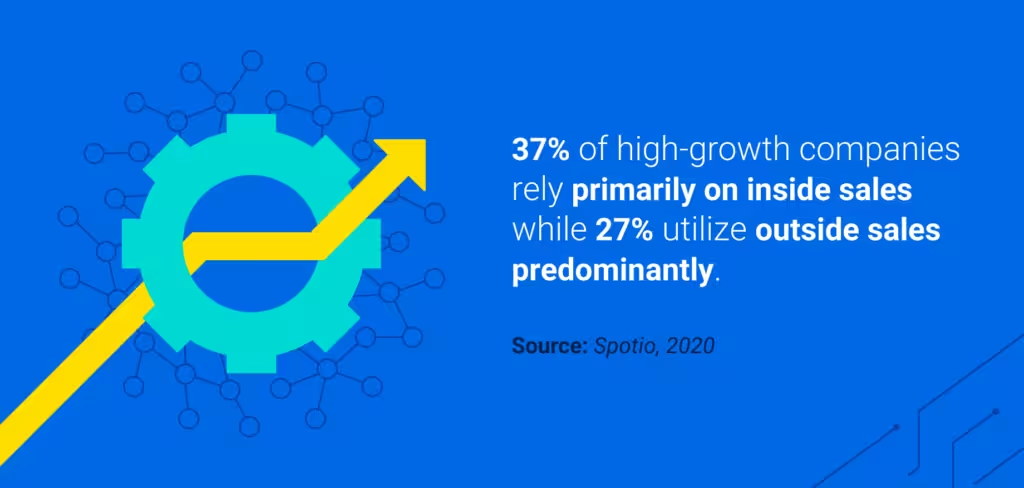Inside Sales vs Outside Sales: What's The Difference?
Inside sales and outside sales are two sides of the same coin. The goal is the same for both (i.e. generate more revenue), but the approach taken is significantly different.
Depending on your industry, product, pricing strategy, target customer, and more, your sales team will look, work, and perform differently. So, when someone asks how you define inside sales vs. outside sales, the answer will certainly be subjective.
In this article, we define inside and outside sales as objectively as possible and discuss tactics to thrive iIn this article, we define inside and outside sales as objectively as possible and discuss tactics to thrive in the changing ecosystem that is blurring the line between traditional inside and outside sales strategies.
What is Inside Sales?
Inside sales are the practice of leveraging technology to connect with and acquire new customers without requiring either party to travel. Today, many inside sales teams use a variety of technologies and communication channels including:
- Phone calls
- Video conferencing
- CRM tools (e.g. Customer Relationship Management)
- Social media
It’s worth reiterating that the product, pricing strategy, and stage of the company will often dictate which channels you use to reach your target customers. Inside sales teams, in the past, focused on a single strategy such as cold calling or email marketing. But today, it’s far more common for teams to use a combination of strategies.
Your market strategy will determine your reliance on an inside sales team, including the number of accounts your reps will be managing, deal size measured in annual contract value (ACV), and sales motion complexity, including the number of decision-makers involved in the average deal.
YInside sales teams typically deal in products and services with lower ACV and sell to a single small buying committee or individual buyer. Geographic growth can warrant a stronger emphasis on inside sales since it reduces the overhead of expanding into global markets by eliminating the need to establish a physical presence there.
What is Outside Sales?
Outside sales, also called field sales, is the practice of traveling to meet with customers.
Outside sales provide current and prospective customers with a personalized sales experience. In-person meetings and face-to-face interactions allow field reps to give more detailed product demonstrations and create more personal relationships with potential clients. Alongside it, however, comes the complexity of a long sales cycle.
The global pandemic has certainly had its impact on the outside sales approach. And while the future of the industry is still uncertain, the reps that have been able to effectively transition to a remote sales environment have set precedence for the role’s evolution.
Trade shows, for example, were once an important component of an outside sales strategy – introducing customers to the company, educating about new and existing products, allowing potential customers to see the physical product firsthand, and networking with prospects.
It’s still unclear whether trade shows or conferences will fully recover or how soon that will happen. In the meantime, we are witnessing a shift in the outside sales industry, forcing incumbents to adopt digital strategies or risk obsolescence.
Inside vs. Outside Sales
Looking at self-reported data from more than 7,600 salespeople in 2020 and 2021, over 56% of sales representatives identify as outside sales reps while 44% consider themselves as inside sales professionals.

Although the tools, processes, and styles of selling for inside and outside sales are starting to converge, each still has its differences, including the sales cycle, skill sets, and metrics.
One of the biggest differences between inside and outside sales is the cost structure. With the need to travel, book accommodations, and schedule client dinners, outside sales representatives require a much larger budget than their counterparts. However, overall, outside sales reps reach higher ACVs and quotas, which usually support the higher expense.
On the other hand, inside sales reps incur costs for things like office space rental, equipment, and office supplies – things that outside sales reps don’t usually need too often. Despite this, inside sales remain more cost-effective, particularly when used for selling mid-market priced products. The trade-off is that inside sales reps need to hit a higher quota for prospects, which they can do by scaling through tech tools.

Differences in Sales Cycle
A sales cycle is the process of turning a prospective customer into a paying customer. Sales cycles are usually expressed as the average time it takes from the initial point of contact with a prospect to a closed sale.
Outside sales pros usually deal with more complex sales cycles that are lengthier due to larger deal size, the necessity of buy-in from more decision-makers in the prospect’s organization, and more back-and-forth negotiation on terms.
Outside sales cycles usually last longer, going for months, quarters, or years. An aerospace company that deals in government defense contracts, for example, is not likely to close a deal worth $600 million in a week.
Inside sales reps usually deal with a shorter sales cycle and lower ACV, often prioritizing quantity over quality when it comes to leads. Inside sales reps will spend more time making calls, sending emails, and otherwise connecting with new prospects, instead of focusing on nurturing a single prospect as outside sales reps tend to benefit from.
Different Sales Tools
You’ve already heard about some of the various tools being employed by inside and outside sales reps to close their deals and achieve their quotas, but let’s cover them in more detail.
Inside sales reps are usually found at their desks, computers, phones, CRMs, and inboxes, while outside sales reps are picking up their rental cars, collecting frequent flier miles, and checking their cell phones in waiting rooms trying to get in front of a decision-maker.
As mobile devices and cloud computing have evolved, some sales technologies of inside sales have begun to bleed into the workflows of outside sales teams. They have their mobile phones for connecting with new prospects, sending and receiving emails, and updating CRMs.
Variations in Skill Sets
When hiring for an inside sales versus outside sales role, you will certainly need to assess skill sets and personality traits to find the best fit for each particular role.
Outside sales, for example, typically requires a high level of situational awareness and emotional Outside sales, for example, typically requires a high level of situational awareness and emotional intelligence (EQ). Your reps need to be able to think quickly, answer questions, pick up on social cues, and keep the conversation with prospects flowing.
Salespeople in the field must also have a high level of autonomy since they are usually motivated and compensated by their own actions and not closely supervised by their sales managers.
Inside sales, on the other hand, requires a high level of focus and the ability to follow instructions. Using a more repeatable, process-driven sales strategy, inside sales teams typically have templates and scripts to guide reps through their workflow as efficiently as possible.
Of course, some abilities are required for both inside and outside sales teams, including effective communication skills, confidence, and perseverance.
Core Metrics That Matter
Both inside and outside sales teams must measure their performance to determine what is and is not working. Although the metrics will measure similar aspects of the sales role at a high level, such as revenue, new logos, pipeline management, conversion rates, and quota attainment, the KPIs are different for each type of sales team.
Inside sales teams will typically measure the performance of their call, email, or other touchpoints against successful connections, opportunities, or closed deals. More telling than mere volume, these ratios measure the actual effectiveness of your inside sales team.
Instead of emails and calls, outside sales teams more likely track the number of meetings, presentations, or demos that resulted in a closed sale. Outside sales teams also place heavier scrutiny on quarterly and annual revenue goals, compared to inside sales teams that are more likely to measure weekly or monthly milestones.
Sales Team Structure
A natural next question might be, is outside sales better than inside sales? Again, the answer will depend heavily on your particular business goals, KPIs, and ACV.
While it’s important to choose a go-to-market strategy and focus on it (mostly to avoid confusion and cannibalizing your own team’s efforts), you will want to experiment with various strategies to find what works best for your business model.
It’s not unusual to find a combination of inside and outside sales teams in large organizations. According to Spotio, 37% of high-growth companies rely on an inside sales strategy primarily while 27% utilize outside sales more predominantly.
These types of companies will usually deploy different strategies for each team to maximize their particular strengths. For example, outside reps may be tasked with closing new logos, while the inside reps are there to upsell and grow current accounts.

With many of the tools inside sales teams use to be successful, paired with the emergence of powerful AI at the fingertips of field sales reps today, a hybrid approach will likely be a trending strategy in sales moving forward.
What Do Inside Sales Reps Do?
Inside sales representatives are expected to take on the following sales responsibilities:
- Acquire leads by making outbound cold and warm sales calls.
- Do extensive research to identify prospective clients before making a sales pitch.
- Establish strong relationships with clients by making follow-up calls to determine where the customer is in terms of their wants and needs.
- Offer product demonstrations, whether it be via pre-made video, live video, or by meeting customers in person.
- Negotiate terms with customers.
- Tap the right agents or sales executives on the sales team who are more qualified or knowledgeable to close a deal.
What Do Outside Sales Reps Do?
In contrast to inside sales reps' responsibilities, here are some of the tasks that outside sales reps must deliver on:
- Travel within their assigned sales territory to meet with existing and potential clients.
- Provide in-person demos of products and services, negotiate terms, and close deals.
- Attend trade shows, conferences, training workshops, and other industry events to seek out potential leads in person, network with other salespeople for future partnerships and market research, and stay on top of industry developments.
- Keep a record of all qualified leads, existing customers, accounts, and sales.
- Send recommendations for marketing strategies for specific regions or demographics, based on insights gathered in their assigned sales territory.
Inside Sales vs Outside Sales Salary
According to Payscale, the average salary of an outside sales representative is $50,539. Entry-level field reps can expect an average total compensation of $42,294, including tips, bonuses, and overtime pay. Experienced outside sales leaders with over 20 years of experience can get up to $60,365 annually.
Meanwhile, inside sales reps can expect a slightly lower salary, with an average rate of $45,082 a year. Entry-level employees with less than a year's worth of experience get an average of $40,435 a year, while high-level sales agents with 20+ years of experience can earn an average total compensation of $50,404.
Inside Sales vs Outside Sales Quota Attainment
Quota attainment refers to the percentage of sales reps who have reached their sales goals within a certain period of time. It can also refer to the total sales attained by a sales team or individual sales professionals within a given time period. Calculating sales quota attainment helps sales managers assess the performance of their team members.
These are some of the most common types of sales quotas:
- Volume-based: This measures how many units or products were sold by a particular sales rep or team.
- Profit-based: This measures the revenues made by the company from product sales or services offered.
- Cost-based: This measures the costs reduced or saved in each deal made.
- Activity-based: This measures the sales activities or sales goals accomplished by a rep or a team within a given time.
So, who has the better sales quota attainment? A 2021 study by The Bridge Group found that only 66% of sales reps reach their annual quota attainment. According to Spotio, outside sales reps tend to outperform inside sales agents, boasting a 10% higher average quota than inside sales agents.
Inside vs Outside Sales Models
A typical inside sales model looks like this:
- Gain qualified leads.
- Establish relationships with potential buyers through digital channels.
- Attempt to close a deal within 90 days or less.
- Spend less and scale with less effort thanks to remote selling.
The field sales model, on the other hand, looks like:
- Travel to prospects and seek to make personal connections face-to-face.
- Present potential customers with products and services in person.
- Close deals in 90 days or more
- Spend more compared to inside sales teams and take more time and effort to scale.
Sales Strategies for Inside and Outside Teams
With major shifts in many business models — like the move from on-premise enterprise to cloud SaaS — sales teams have had to adjust their strategies and learn what works best for their business. Below are some strategies to consider:
Product-Led Sales Strategy
Some products, such as general-purpose SaaS, can rely on product marketing alone to drive growth in sales through a self-serve customer acquisition process, reducing the need for a sales force.
Although this seems great, it’s important to know when your product might require a salesperson to demo the product, an onboarding specialist to get a new customer off the ground, or a retention specialist to expand current customer lifetime value (LTV).
Outbound Sales Strategy
If you have exhausted your product-led growth opportunities or serve a market that requires a more active outbound sales process, you’ll want to evaluate building an inside and/or outside sales team.
One important consideration when structuring a sales team is measuring your ACV or customer lifetime value (LTV) against your customer acquisition cost (CAC). If the ratio is less than 1, your sales model is unsustainable and likely to fail.
DocSend, a secure file sharing service, realized their ACV simply wasn’t high enough to justify their outbound sales strategy and decided to pivot, now relying entirely on inbound strategies.

If your ACV/CAC ratio is less than two, but the lifetime value of your customer is significant, it can still make sense to invest in your outbound sales strategy.
If hiring a sales team will drive your customer acquisition cost up to $20,000 and your ACV is only $25,000, your ACV/CAC ratio is 0.8 and will be wholly unprofitable. If your LTV is $50,000, on the other hand, the LTV/CAC is 2.0 – a far more favorable ratio.
Should You Outsource Your Inside Sales Team?
For many companies, outsourcing inside sales is a practical way to scale their business quickly. Outsourcing sales reps allows you to save on costs that would otherwise go to recruiting, hiring, and training in-house teams.
Aside from this, hiring an outsourced sales team means that you get to skip the tedious process of building an effective outbound marketing and sales process. Hire an already established, high-performing sales team, and you get employees who already know all the right ways to cold call, pitch, prospect and nurture leads, and use the latest sales management tools to their full potential.
You should consider outsourcing your inside sales team if you want to:
- Slash your sales costs
- Expand into new markets within a short period of time
- Give your current sales teams more time for outside sales
Inside & Outside Sales Statistics

Numbers can be helpful in understanding overall trends and identifying which model works best for your business (or whether you ought to adopt a hybrid model). Here are eight statistics that can guide your decision:
- Outside sales professionals make an average of 14% more than their inside sales counterparts. (Spotio)
- However, inside sales are said to be growing 15x faster than outside sales. (SalesLoft)
- Three-fourths of buyers prefer not to meet sales agents face-to-face. (SalesLoft)
- Ten inside sales representatives are hired for every one outside sales rep. (SalesLoft)
- Inside sales are more cost-effective than outside sales – the average inside sales call costs only $50, while the average outside sales call costs $308. (Hubspot)
- Nearly half of all fast-growing tech companies use inside sales, while only 21% use outside sales. (Harvard Business Review)
- It takes an average of 8 cold call attempts for a sales rep to reach a prospect. (The Brevet Group)
- Outside sales reps have a 40% closing rate, on average. (Zippia)
Which Sales Strategy Is Right For Your Business?
Now that you’ve explored whether a sales-led organization is a sustainable growth strategy, you’re probably wondering what your specific strategy should be. Whether you build out a self-service portal, inside sales team, outside sales team, or a combination of inbound and outbound, the important thing is to test different strategies, measure performance, and learn from what works and what doesn’t.
Most companies have the data but lack the capabilities to extract the lessons. Leverage technology to learn from your data and train your sales team on the tactics that are disproportionately effective for closing or losing deals. Analyze your team’s workflow to identify inefficiencies and determine what can be abstracted or automated from the process, increasing productivity.
Sales teams have traditionally analyzed their sales data against their end goal to determine progress and quota attainment, but by the time they realize they are not on track, it’s too late to make corrective maneuvers. You must instead track leading indicators (as opposed to lagging indicators) in your sales analytics strategy if you truly want to impact performance.
Leading indicators are the predictive insights that can act as early detection for when things are going right and when things aren’t. If you focus on the carrot, you will constantly be one step behind; however, if you instead focus on the stick, you can see where the carrot is going.
Modern companies must implement this cycle of testing, assessing, and investing (or divesting). It is essential we learn from our experiences, compile a playbook, and coach our team towards this winning strategy. People.ai is a platform built with patented AI technology for sales, marketing, and DevOps teams to transform their business activity into insights, ROI, and growth. Our sales intelligence platform helps identify your “stick”, evaluating the inputs from your sales data to predict the output of your team.
Frequently Asked Questions About Inside vs Outside Sales
What do inside sales reps do?
Inside sales reps find potential customers, establish relationships with leads, and present products and services remotely, either via phone or computer.
What do outside sales reps do?
Outside sales reps take on a more traditional role, traveling to prospective clients and presenting products and services in person.
Should you use inside or outside sales?
Both inside and outside sales models have their own unique benefits – whether you should use one or the other (or both) depends on the type of business you're running, your product, your pricing strategy, your target customers, etc.
Which sales strategy is right for your business?
There is no one-size-fits-all strategy. Each business should test different strategies and measure performance to determine what works and what doesn't.
Related Insights
Explore more expert insights on AI adoption, sales execution, and revenue intelligence to help your team close more deals with confidence.



